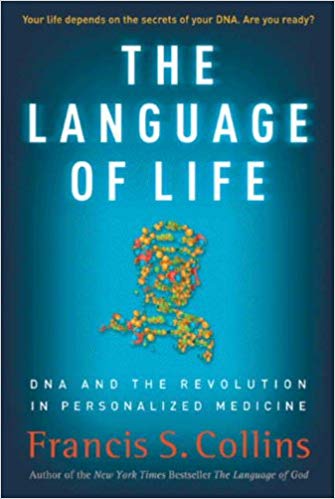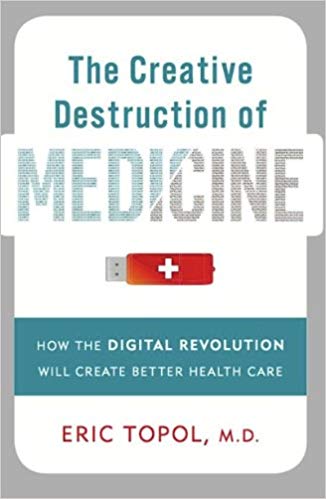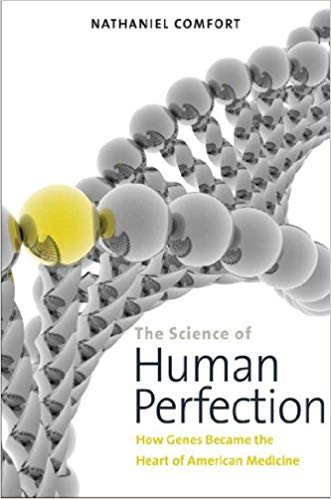YouGenics: The Decoding of Personal Health
The Language of Life: DNA and the Revolution in Personalized Medicine
Francis S. Collins. 2010. HarperCollins, New York. 368 pages.
The Creative Destruction of Medicine: How the Digital Revolution Will Create Better Health Care
Eric Topol. 2012. Perseus Books Group, Basic Books, New York. 320 pages.
The Science of Human Perfection: How Genes Became the Heart of American Medicine
Nathaniel Comfort. 2012. Yale University Press, New Haven, CT. 336 pages.
For the past decade following the initial decoding of the human genetic code or genome, we have repeatedly heard and to some degree assimilated the message that understanding our genes is the foundation of a new era of health and wellness. Just as the discovery of antibiotics and the invention of vaccines opened new vistas in the management of infectious disease, so the genome offers a window into a much more personal level of treatment and care.
DNA is becoming a second language of sorts because of its most attractive promise: customized, personalized medicine. The Human Genome Project (HGP) is not just about cells somewhere in a lab or under a microscope; it’s personal now. This is about your cells, how they function and why they fail. But will this knowledge, this you-genics, have a collective eugenic effect as well? We may shudder at the idea that burgeoning genetic knowledge is leading to designer babies and a future society of genetic haves and have-nots. But it’s hard to turn down drugs designed to counter our specific diseases (not just cancer, but my cancer). That, of course, is the personal appeal of DNA technology.
Concerning the deeper meaning of the HGP, bioethicist Gregory Stock wrote a decade ago that this knowledge would bring access and familiarity on a new scale, along with new challenges: “We will have to face how our genetics circumscribes our potentials, our vulnerabilities, and even our personalities.” In Redesigning Humans: Our Inevitable Genetic Future (2002), Stock continued, “Our genes will not tell us our destiny, but they will speak to us, and we would do well to listen.”
And many have been listening and no doubt writing, as the variety of books now available concerning the future of genome-based medicine is rapidly increasing. Three recent volumes are of interest not only because they describe the emerging alliances between genomics, the medical industry, the individual and society at large; in their overlap they also lend valuable perspective to the collective consequences of our desires for improved health.
Getting Personal
In The Language of Life, Francis Collins, a physician-geneticist and current director of the National Institutes of Health (NIH) in the United States, focuses on the individual. He posits that “careful analysis of the complete content of your genome will allow a considerably more useful estimate of your future risks of illness than is currently possible, enabling a personalized plan of preventive medicine to be established.”
Collins begins by explaining how easy it is to obtain a personal genetic profile and why we should all have it done. He is enthusiastic in showing that our genes have something important to tell us.
The renowned researcher headed the NIH arm of the Human Genome Project to its 2003 completion, so it is not surprising that he takes an optimistic view of the power of genetic information. “Each of us is at risk for dozens of conditions, which we will either experience or not—as a result of the combination of risk factors we have inherited, and whether or not we encounter the environmental trigger that sets the disease process in motion.” His notion that “there are virtually no conditions for which heredity does not play a role” led him to obtain his own DNA analysis (a process called genotyping).
The anecdote-heavy Language of Life tells of his genetic denouement. It is a continuing adventure, because once a genetic predisposition is revealed, there is no unknowing it. Collins reports that there was some disagreement between the results posted by the screening companies he used, but “despite all of the limitations of the data, the disclosure of this personalized genetic information provided a motivator for specific actions.”
“As we move ever closer to a full understanding of personalized medicine, each individual case of illness will need to be properly placed along the spectrum of genetic and environmental causes in order to design the most effective treatment.”
He believes that this capability offers real hope, and he frames his book around the practical ways he has learned to use it: “As I experienced myself, learning your own DNA secrets can be the best strategy for protecting your health and your life.” Because “the success of personalized medicine will come about only when we each take responsibility for our health,” he stresses—as any doctor would—the importance of family health histories and an appropriately healthy lifestyle.
Along these lines, each chapter in the book ends with a helpful “What You Can Do Now” section, encouraging the reader to take advantage of the advances in preventive health care that the new technologies offer. Collins notes that DNA is in some ways prophetic; it reveals what might happen next. Borrowing advice from the coach and father of hockey legend Wayne Gretsky, he says, “You need to skate where the puck is going to be.” But because he is all-in both professionally and personally, Collins offers little in terms of the possible downsides of genotype revelations.
High-Def Medicine
For medical doctor Eric Topol, director of the Scripps Translational Science Institute, the larger question is whether or not the medical industry can keep up with the moving puck as even more personalized information becomes accessible.
“Our go-to source for health and medical information is moving away from our doctor—it is increasingly by crowdsourcing and friendsourcing our entrusted social network.”
The patient’s genetic profile is barely the beginning of the possibilities. The convergence of technologies—in this case DNA sequencing, wireless communication, and instant access to databases—has made it possible to engineer a completely new system for monitoring wellness and diagnosing disease. In The Creative Destruction of Medicine, Topol explains how we are on the cusp of linking personal molecular data with clinical decision-making.
“Like a syzygy with alignment of the sun, the moon, and the Earth,” he writes, “we have a propitious convergence of a maturing Internet, ever-increasing bandwidth, near ubiquitous connectivity, and remarkable miniature pocket computers in the form of mobile phones,” not to mention the amazing capacity for data storage and cloud computing.
Embracing what he calls “the C’s” (Constant Connectivity, Collaboration and Crowdsourcing, Customized Consumption, and Cloud Computing), Topol argues that it’s time for a revolution in the way the medical industry operates. “The creative destruction of medicine” is upon us, he says, because the C’s have led to the D’s (Disruption and Destruction, Dealing With a Data Deluge, and a Data-Driven Culture).
Topol spends much of his book rallying against “eminence-based medicine”—“one dose fits all” drug prescribing based on symptoms gathered from large population studies. His alternative takes the diagnostic process beyond Collins’s suggestions: now treatment can be based on a fine-tuned around-the-clock individual diagnostic. “We are each unique human beings,” writes Topol, “but up until now there was no way to establish one’s biologic or physiologic individuality.”
That will soon change, because new microsensor apps, which can be downloaded to one’s cell phone, will enable the 24-7 monitoring of anyone’s body metrics without the need to be wired to machines in a hospital. Just as book stores have become nearly obsolete, so office-visit-based medicine may not be the necessity it once was. This is a fundamental change in the health-care business plan: “The ability to digitally define the essential characteristics of each individual—the high-definition human—sets up a unique era of medicine.”
But participation in this new diagnostic realm is not without cost. And although DNA-sequencing tests can now be found for less than US$300, what an individual can do with that information remains limited.
For one thing, the association between gene variant and disease is not always clear-cut. There remains much to be learned about disease and its causes. How a genetic disposition actually translates into a particular clinical condition is still a mystery. As Topol points out, it may be possible to monitor an individual’s unique responses to disease and treatment, but putting a meaningful interpretation to the data is not yet possible. By analogy, just as the potential futures of a car with a hidden oil leak are largely determined by the habits of the driver, a “faulty” gene operates in conjunction with many other variables; one’s full complement of gene variants interacts in unique ways programmed through myriad influences, including the nuances of lifestyle and environmental impacts from conception onward. (See “The Ripple Effect”.)
Our understanding of these interactions may never be complete. So it seems that eliminating the precursory factors, the disease-associated genes of which we are the most sure, may be the easiest path to health. That type of intervention, however, embodies the eugenic principles that remain a kind of third rail in the health-and-wellness debate. Genetic screening is already available in a limited way through pre-implantation genetic analysis of IVF embryos and cellular diagnostics of fetuses in the womb. Clearly genetic flaws (and how these are defined can be open to interpretation) in an IVF embryo would negate its use. For the fetus, information before birth could be used in aiding its development or in planning its postbirth environment.
That information could also be used in deciding to terminate the pregnancy. “The ethical dilemmas and controversies that lie ahead in the era of digitized humans are undoubtedly going to be polarizing,” admits Topol.
The Eugenic Connection
None of this is really new to science historian Nathaniel Comfort. As he explains in The Science of Human Perfection, the goal of improving the human condition has been the target for decades; the problem was that no one understood a scientific means to the desired end. Although we shy away from the term eugenics because of its racist and Nazi baggage, Comfort argues that we have finally reached the point in time when the goal of the early eugenicists, a kind of medical heredity, is possible.
“The greatest risk of hereditary determinism may be not the results it produces but the alternatives to which it blinds us. It obscures the power of diversity, the beauty of chance, and the virtues of tolerance, by creating an illusion of perfectibility.”
According to Comfort, developing the kind of genetic screening that’s possible today was the long-time goal of the eugenics movement. While it began with proposals to control parental reproductive decisions, today we have discovered the gene as the locus of much broader control, the basis for intervention. “Nature” need not be left to follow its own course.
“Eugenics is treated as exceptional, a scientific/social/political movement bound in time, an unfortunate phase in the history of human genetics,” he writes. In the early 20th century, “genetic improvement . . . was the ultimate in preventive medicine.” It is a mistake, he believes, to claim that this attitude was time-bound to the past. It remains the foundation of today’s genomics: “There remains in much of the scholarly discussion a sense that eugenics is a contaminant of good, honest biomedicine. In contrast, in this book I treat human improvement and the relief of suffering as the two goals of all eugenics—and all medical genetics.”
Comfort brings a longer-range social perspective to the problem of genome-based health care. It is rare to find such a view, because for the most part, if we hear anything at all about the history of genetic medicine, it begins with either the discovery of the DNA double helix in 1953 or the race to decode the human genome, which began in 1990. He argues that while the technological capacity to intervene in our genetic makeup at the cellular level is new, our desire to do so is not.
At the turn of the 20th century, reproductive selection was already being theoretically applied as a means of improving the human population. A century later we have moved away from explicitly focusing on the human species as a whole or on national gene pools; we have turned genetics into a business rather than a social cause. “We are taking evolution into our own hands, as the early eugenicists had wished, but we are doing it with no design, no higher purpose, no public spirit,” Comfort says. “Driven by technological power that outstrips biological understanding and guided by the principles of individual gain rather than social progress, the pursuit of human perfection becomes short-sighted and self-centered, both for better and for worse.”
Such statements can make it seem that Comfort is pushing for a return to a more collective eugenic thinking, a somehow more honest view of genetic science as a tool for enhancing the population rather than the person. But he is not. Rather, he is saying that genetic solutions will not solve the deep problems of human satisfaction, although the success of our science has made this seem possible. “The eugenic impulse arises whenever the humanitarian desire for happiness and social improvement combines with an emphasis on heredity as the essence of human nature. It is the dream of control, of engineering ourselves, of not leaving our future up to cruel fate.”
And as Topol and Collins note, what happens next is ultimately determined by what the individual will do with the information at hand. Whether through genotyping, vital-sign monitoring or family history, all three authors agree that we must each take responsibility for what we know. But how far we will go with that information also depends on the collective will. Just as the post-Flood generations of the Bible sought security in building cities and high towers, so we all want a way out of our health deficiencies—to somehow stay above the floodwaters of disease. But will this desire spin off into a cultural and ethical dystopia that eliminates the disease by eliminating the patient?
Some, Collins demonstrates, will take these new insights to heart and allow them to inform their meditation on personal lifestyle. This may motivate changes that could enhance health on the personal level in ways that need not challenge societal norms. Focusing on the positive, Collins promotes the theme that everyone would be better off and society as a whole would benefit if we were all more health-conscious in our choices.
But others, as Topol discovered, seem oblivious to personal data one way or another. His ongoing study called the Scripps Genomic Health Initiative follows volunteers who underwent appropriate counseling after their genotypes were scanned. While later surveys uncovered no evidence that these people had experienced any heightened anxiety or depression from their results, Topol reports that, “unhappily, there was also no clear evidence of lifestyle improvement or of undergoing appropriate screening tests related to conditions of risk, but there was strong support for intent to have such tests.”
Even if these are fully embraced, Comfort says, we will be missing the simpler solution. We have allowed ourselves to be lulled into believing that DNA is more than it really is: “Human happiness is overdetermined—more than one set of causes can provide a complete account of it. Even a full molecular explanation of health or intelligence or personality would not preclude an equally complete explanation in terms of upbringing and training.”
The important point in Comfort’s words is that much of what happens to us, our successes and failures, state of health or conditions of distress, is related to the world we live in together, not the world of our individual biology.
Missing Code
Comfort points out that somewhere we have missed the right order of things, misread the code, misunderstood the right sequence. He appreciates that the double helix structure of DNA has always been deceptively simple, and from that insight he offers a most important conclusion overlooked by the others: “Heredity trumps environment by collective decision, not natural necessity,” he says. “We choose to explain human nature in terms of heredity because it offers technological solutions that, challenging and expensive as they may be, are ultimately easier and sexier than social solutions.”
As our genes “speak to us,” we will not only be hearing as individuals but as communities, nations and, ultimately, a species. Because it is unlikely that we will ignore what we hear, the emerging pattern that leads from individual hope to population manipulation will grow not only less opaque but more invasive.
Technological innovation tends to give us a sense of security. While there are always costs to the benefits, we are naturally inclined to focus on the benefits; this is especially true when we think of our lives and our physical comfort. But like the tower of Babel, whose builders believed they could outwit their Creator with their ingenuity, the costs often pile up in ways that are in the end even more destructive.



